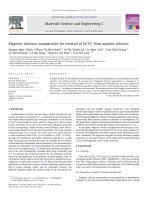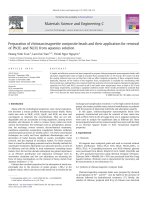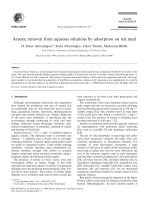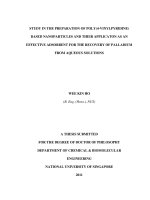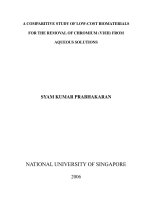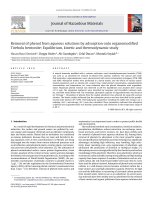C@TiO2 core-shell adsorbents for efficient rhodamine B adsorption from aqueous solution
Bạn đang xem bản rút gọn của tài liệu. Xem và tải ngay bản đầy đủ của tài liệu tại đây (5.84 MB, 8 trang )
Microporous and Mesoporous Materials 320 (2021) 111110
Contents lists available at ScienceDirect
Microporous and Mesoporous Materials
journal homepage: />
C@TiO2 core-shell adsorbents for efficient rhodamine B adsorption from
aqueous solution
Kang Li a, Liang Yu b, *, Juanjuan Cai a, Lixiong Zhang a, **
a
b
State Key Laboratory of Materials-Oriented Chemical Engineering, College of Chemistry and Chemical Engineering, Nanjing Tech University, Nanjing, 211816, China
Chemical Technology, Luleå University of Technology, SE-971 87, Luleå, Sweden
A R T I C L E I N F O
A B S T R A C T
Keywords:
ZIF-8
Titania
C@TiO2 adsorbents
Rhodamine B
Wastewater treatment
In the present work, C@TiO2 core-shell adsorbents were successfully prepared and the adsorption capacities for
rhodamine B (RB) were investigated at different conditions. The adsorbents were prepared by first in-situ hy
drolysis and deposition of TBOT on the surface of ZIF-8 nanoparticles to obtain ZIF-8@titania gel, and then
carbonization. XRD, SEM, TEM, and N2 adsorption-desorption techniques were employed to characterize the
adsorbents. The results showed that the adsorbents were comprised of TiO2 shell and carbon core. Large surface
area and hierarchical pores, which were different from ZIF-8 derived porous carbon, were generated due to the
less contraction of carbon during carbonization when robust TiO2 shell covered on the surface. The highest
adsorption capacity for RB was 298 mg/g on C@TiO2. Apart from the hierarchical pores and large surface area,
the low surface charge of C@TiO2 core-shell adsorbents was also observed, which also contributed to the high
adsorption capacity for cationic dyes. The reuse experiments showed that the adsorbents maintained the high
adsorption capacity after 5 cycles. The high stability is crucial for practical application.
1. Introduction
Adsorption, as an efficient process for wastewater treatment, has
drawn much research attention. Therefore, the development of high
performance and cost-effective adsorbents for the removal of organic
contaminants like dyes from textile dyeing effluents are of a great in
terest [1–3]. Porous carbons have been considered as efficient adsor
bents for various adsorption applications due to the porous structure,
high stability and environmentally friendly properties. However,
microporous biochar [4] and activated carbon [5] displayed low
adsorption capacities of 86 and 55 mg/g, respectively, for RB. The low
adsorption capacity resulted from the small pore size. Higher adsorption
capacities of 284 and 423 mg/g were observed for brilliant yellow and
RB on mesoporous carbons due to the larger pore size and pore volume
[6]. Graphene-like porous carbon with even higher surface area (1710
m2/g) and pore volume (0.83 cm3/g) showed excellent adsorption ca
pacity of 418 mg/g for methyl orange [7]. However, for many carbon
materials, the preparation procedures were complicated and the im
provements of pore systems and surface chemistry are needed from
higher adsorption performance.
Many methods have been developed to prepare carbons with unique
structures [8] and surface chemistry for higher adsorption capacity [9].
Carbon composites combined the advantage of at least two materials,
which could display significantly higher adsorption capacity than the
single component materials. For instance, porous carbon nanosheets
(PCNSs) comprised of two different carbons sources were prepared by
carbonizing of waste plastics covered organically-modified montmoril
lonite. The surface area (2315 m2/g) and pore volume (3.3 cm3/g) of the
carbon materials were large, and the surface zeta potential was low.
Therefore, the adsorption capacity for methylene blue was unprece
dentedly high about 769 mg/g [10]. For RB adsorption, an adsorption
capacity of 625 mg/g on montmorillonite/graphene oxide nano
composites was observed, which was higher than that of montmoril
lonite and graphene oxide [11]. The synergistic effect of the components
in the nanocomposites contributed to the high adsorption capacity [11].
In addition, composites could generate hierarchically structured porous
materials, which can improve the mass transfer efficiently.
Our group also developed several composites that showed high
performance for gas upgrading and wastewater treatment. For example,
NaX/NaA core-shell microspheres showed a higher adsorption
* Corresponding author.
** Corresponding author.
E-mail addresses: , (L. Yu), (L. Zhang).
/>Received 15 February 2021; Received in revised form 20 March 2021; Accepted 13 April 2021
Available online 16 April 2021
1387-1811/© 2021 The Authors.
Published by Elsevier Inc.
This is an
( />
open
access
article
under
the
CC
BY-NC-ND
license
K. Li et al.
Microporous and Mesoporous Materials 320 (2021) 111110
2. Experimental
2.1. Synthesis of ZIF-8 nanoparticles
The detailed procedures for the preparation of ZIF-8 have been
described in literature [18]. Briefly, dissolved 2.3 g Zn(NO3)2•6H2O and
32 g 2-methylimidazole in 16 and 112 g water, respectively. Afterward,
the 2-methylimidazole aqueous solution was added into the Zn
(NO3)2•6H2O aqueous solution quickly under vigorous stirring condi
tions. The centrifuge was used to recover the product after stirring for 3
h and then freezing dry.
2.2. Preparation of TiO2 coated carbon nanoparticles
The obtained ZIF-8 (0.1g) was dispersed in 40 ml ethanol and added
0.062 g tetrabutyl orthotitanate (TBOT) under stirring condition. The
mass ratio of ZIF-8 and TBOT was 1:0.62. After stirring for 1 h, 70 ml
water was added into the solution using a syringe pump. The flowrate
was 1 ml/min. Then, the mixture was stirred for 12 h at room temper
ature. The obtained product was recovered by centrifuge. The sample
was denoted as ZIF-8@titania gel-1. Meanwhile, ZIF-8@titania gel-2
and ZIF-8@titania gel-3 were also prepared using the mass ratio of ZIF-8
and TBOT of 1:1.25 and 1:2.50, respectively.
ZIF-8@titania gel-1, ZIF-8@titania gel-2, and ZIF-8@titania gel-3
were carbonized under nitrogen atmosphere to obtain C@TiO2-1,
C@TiO2-2, and C@TiO2-3, respectively. The carbonization temperature
was 700 ◦ C and the time was 2 h. ZIF-8@titania gel-2 sample was also
carbonized at 850 and 1000 ◦ C to investigate the effect of carbonization
temperature, the obtained products were denoted as C@TiO2-850 and
C@TiO2-1000, respectively.
Fig. 1. Observed XRD patterns of as-synthesized titania gel, ZIF-8@titania gel2, and ZIF-8. Blue bars represent the reference XRD pattern of ZIF-8. (For
interpretation of the references to colour in this figure legend, the reader is
referred to the Web version of this article.)
selectivity for CO2/N2 compared to NaX microspheres [12]. Hollow
zeolite NaA/chitosan composite microspheres prepared in a simple
microchannel device showed an adsorption capacity of 16 mg/g for
Cu2+ from water at the studied conditions [13]. Carbon/cobalt com
posites were simply prepared by carbonization the mixtures of phenolic
resin and ZIF-67. The composites displayed high adsorption capacity of
2778 mg/g for tannic acid. In contrast, the adsorption capacity was 205
and 1375 mg/g on phenolic resin and ZIF-67 derived carbons, respec
tively [14]. Core-shell composites prepared by coating one component
on the surface of the other can exhibit different properties for different
applications due to the change of the surface chemistry [15]. Recently,
we reported a C@silica core-shell adsorbent for the adsorption of cip
rofloxacin [16]. ZIF-8 was used as the carbon source. Moreover, ZIF-8 is
a microporous metal-organic framework material composing of Zn cat
ions coordinated to 2-methyimodazole linkers. The observed adsorption
capacity was1575 mg/g at the optimum adsorption conditions. Besides,
the results also showed that the charge on the core-shell nanoparticles
was more negatively due to the effect of silica shell, thereby improving
the adsorption capacity. Very recently, we also reported a porous C@C
composite adsorbent for the adsorption of dye contaminants from water.
The adsorbents were prepared from the carbonization of resorci
nol–formaldehyde (RF) resins@ZIF-8 composites [17]. The surface area
of the C@C composite adsorbent was much higher than the single
components derived carbons. Meanwhile, the pore size of the C@C
composite adsorbent was slightly larger. Therefore, the adsorption ca
pacities of the composite adsorbents for methylene blue and RB was as
high as 681 and 462 mg/g, respectively. Interestingly, the results also
showed a lower surface charge on composite, which also enhanced the
adsorption. All the developed composites displayed high stability and
could be recycled easily, meanwhile, maintained high adsorption ca
pacity. In addition, the results also indicated that surface modification is
an efficient method for the preparation of high performance adsorbents.
In the present work, we prepared C@TiO2 core-shell adsorbents by
carbonizing ZIF-8@titania gel core-shell composites. The titania gel
coated on the surface ZIF-8 particles by hydrolysing and depositing
TBOT. To optimize the preparation conditions, different ratios of TBOT
to ZIF-8 and carbonization temperatures were investigated. The effect of
TiO2 shell on the pores and surface chemistry of ZIF-8 derived porous
carbon were explored. The obtained composites were used for RB
adsorption and the adsorption conditions were optimized. Meanwhile,
the adsorption mechanism was discussed.
2.3. Adsorption experiments
All adsorption experiments were carried out at 30 ◦ C and the tem
perature of the solution was controlled by an oil bath. C@TiO2 nano
particles (2.5 mg) were added in 50 ml RB aqueous solutions with the
concentration of 40 mg/l for adsorption. Sodium hydroxide (0.1 M) or
hydrogen chloride (0.1 M) aqueous solution was used to adjust the pH.
The adsorption loading at different adsorption times was determined by
analysis of 1 ml solution taken from the bulk solution. Prior to analysis,
the collected solutions were filtered using 10 μm filter and diluted 10
times. RB aqueous solutions with the concentration from 20 to 100 mg/l
were used to determine the adsorption isotherms. A MAPADA UV-1800
PC spectrophotometer was employed for the determination of RB con
centration at a wavelength of 544 nm.
The adsorption loading q for RB was defined as:
q=
V
(C0 − Ct )
m
Where V (ml) is RB aqueous solution volume, m (mg) is the mass of
C@TiO2 used for adsorption, C0 (mg/l) and Ct (mg/l) are the concen
tration of RB before and after adsorption.
2.4. Materials characterizations
Bruker D8 Advance powder X-ray diffractometer (Cu target) was
used to record XRD patterns with the tube voltage and current of 40 kV
and 40 mA, respectively. SEM images was recorded using a field emis
sion scanning electron microscope (Hitachi− S4800). JEOL JEM-2100
transmission electron microscope was employed to recorded TEM im
ages. BELSORP II instrument was used to measure the N2 adsorptiondesorption isotherms at 77 K. The samples were treated at 150 ◦ C for
6 h under vacuum before the measurement. The BET method was used to
calculate the surface area and the total pore volume was estimated at p/
p0 of 0.99.
2
K. Li et al.
Microporous and Mesoporous Materials 320 (2021) 111110
Fig. 2. Morphology of titania gel (a), ZIF-8 (b), and ZIF-8@titania gel-2 (c) observed by SEM.
Fig. 3. XRD patterns (a) and SEM images of ZIF-8@titania gel-1 (b) and ZIF-8@titania gel-3 (c).
3. Results and discussion
ethoxy group (CH3CH2O–) that presented on the surface of the hydro
lysed titania gel and affected the phase change of the gel during drying
[20].
SEM images of titania gel, ZIF-8, and ZIF-8@titania gel-2 are given in
Fig. 2. The SEM image of titania gel shows a structure of agglomerate
particles and uneven size. The size of the crystals has not changed
obviously indicated that a thin titania gel layer covered on ZIF-8 crys
tals. Therefore, the morphology of ZIF-8 crystals was preserved in ZIF8@titania gel-2. To identify the particle sizes of the obtained samples,
100 particles from each SEM image were measured, and the average
particle sizes of 78 ± 17 and 106 ± 20 nm were obtained for ZIF-8
3.1. ZIF-8@titania gels particles
As shown in Fig. 1, the crystalline structures of the prepared titania
gel, ZIF-8, ZIF-8@titania gel-2 were characterized by XRD. The XRD
pattern indicates a high quality ZIF-8 that is confirmed by the simulated
XRD pattern of ZIF-8 as indicated by blue bars [19]. No impurity peak
was detected. Due to the effect of amorphous titania gel, the peaks in
tensity of the ZIF-8 became weaker after coating with titania gel.
Moreover, the amorphous structure of titania gel resulted from the
3
K. Li et al.
Microporous and Mesoporous Materials 320 (2021) 111110
Fig. 4. XRD (a), SEM image of TiO2 (b), C (ZIF-8) (c) and C@TiO2-2 (d) as well as TEM image of C@TiO2-2 (e).
Fig. 5. SEM images of C@TiO2-850 (a) and C@TiO2-1000 (b).
crystals and ZIF-8@titania gel-2, respectively. Therefore, the thickness
of titania gel layer was about 14 nm. More details about the structure of
the ZIF-8@titania gel-2 will be discussed below.
ZIF-8@titania gel-1 and ZIF-8@titania gel-3 particles prepared from
different mass ratios of ZIF-8 and TBOT were characterized by XRD and
SEM. The results are given in Fig. 3. The peaks intensity was weaker with
the increase of TBOT due to the thicker titania gel shell on ZIF-8 crystals,
meanwhile, the particles became more agglomerated. The average
particle size was about 82 ± 18 nm for ZIF-8@titania gel-1 and 120 ± 21
nm for ZIF-8@titania gel-3, the corresponding titania gel shell thickness
was about 2 and 21 nm, respectively.
3.2. C@TiO2 particles
The XRD patterns of C@TiO2-2, ZIF-8 derived porous carbon and
pure TiO2 that were carbonized at 700 ◦ C under N2 atmosphere are
shown in Fig. 4a. XRD pattern of the pure TiO2 shows a mixture of
anatase and rutile phases. This is different from that of the C@TiO2-2,
which solely showed a rutile structure. It is important to note that ZIF-8
derived porous carbon was an amorphous structure as indicated by XRD
pattern. Therefore, the differences of phases of TiO2 between pure TiO2
and C@TiO2-2 resulted from the effect of carbon on the phase trans
formation of TiO2 at high temperature. It has been reported that the
4
K. Li et al.
Microporous and Mesoporous Materials 320 (2021) 111110
Fig. 6. N2 adsorption-desorption isotherms of samples prepared at different conditions.
strong reducing agent, carbon could enhance the formation of oxygen
vacancies in an inert atmosphere thereby promoting the reconstructive
process [22]. This could explain that almost only rutile was observed in
the C@TiO2-2 composite.
The morphologies of titania gel and ZIF-8@titania gel-2 were pre
served after high temperature treatment (see Figs. 2 and 4). For titania
gel, carbonization could be considered as a deep drying process [23].
Therefore, the morphology could probably be similar, i.e. irregular
shape, but smaller size. Due to the stable structure of TiO2, the TiO2 shell
could maintain the morphology of ZIF-8@titania gel-2. Therefore, the
morphology of C@TiO2-2 was similar to ZIF-8@titania gel-2 after high
temperature treatment. Furthermore, TEM image in Fig. 4e clearly
shows a core-shell structure of C@TiO2-2. A rational hypothesis is that
the core-shell structure comprised of a TiO2 shell with carbon core and
the robust TiO2 shell maintained the morphology of ZIF-8@titania gel-2.
Table 1
Summary of the textural properties of materials prepared at different conditions.
Samples
Surface area
(m2/g)
Total pore volume
(cm3/g)
Average pore size
(nm)
TiO2
C (ZIF-8)
C@TiO2-1
C@TiO2-2
C@TiO2-3
C@TiO21000
21
496
371
264
113
516
0.1
0.6
1.2
0.8
0.5
1.0
n/a
3.9
12.4
11.7
16.0
7.4
Fig. 7. Effect of contact time on the adsorption capacity of ZIF-8 derived
porous carbon, TiO2, C@TiO2-1, C@TiO2-2 and C@TiO2-3 for RB.
transformation from anatase to rutile is a reconstructive process. In this
process, the chemical bonds will be broken and reformed at high tem
peratures (>600 ◦ C) [21]. Apart from temperature, the particle size,
atmosphere, and dopant will also affect the phase transformation. As a
Fig. 9. Adsorption capacity of C@TiO2 prepared at different carbonization
temperatures for RB. The precursor of C@TiO2 was ZIF-8@titania gel-2.
Fig. 8. Adsorption of C@TiO2-2 for RB at different pH (a) and the zeta potential of ZIF-8 derived porous carbon and C@TiO2-2 as a function of pH (b).
5
K. Li et al.
Microporous and Mesoporous Materials 320 (2021) 111110
Fig. 10. Langmuir (a) and Freundlich (b) linear fitting of adsorption data.
However, a different structure was observed for C@TiO2-1000, which
could be ascribed to the zinc component in the ZIF-8@titania gel. The
zinc could be evaporated at carbonization temperature due to the low
boiling point [24]. Therefore, C@TiO2-1000 with a more porous struc
ture was observed.
Fig. 6 shows N2 adsorption-desorption isotherms of C@TiO2-1,
C@TiO2-2, C@TiO2-3, and C@TiO2-1000 as well as TiO2 and ZIF-8
derived porous carbon. TiO2 showed the lowest adsorption for N2 due
to the low surface area [25]. The steep and high uptake at low relative
pressure range (close to zero) indicated that ZIF-8 derived porous carbon
has abundant micropores that was similar with that of activated carbons.
No hysteresis loop was observed for isotherms of ZIF-8 derived porous
carbon that indicates a monomodal pore system. Type IV adsorption
isotherms were obtained for all core-shell composite adsorbents. The
adsorption isotherms of C@TiO2 showed high nitrogen adsorption ca
pacity at low pressure range and large hysteresis loop that indicated the
materials have abundant micropores and mesopores. Meanwhile, the
adsorption isotherms of the composites at p/p0 around one increased
sharply, which resulted from the macropores. Therefore, the results
indicated that the synthesized core-shell composites were hierarchically
porous materials.
The surface area of C (ZIF-8) was 496 m2/g (see Table 1), and it
decreased when the TiO2 content increased at the carbonization tem
perature of 700 ◦ C. However, the surface area was significantly high for
sample carbonized at 1000 ◦ C due to pores generated during evapora
tion of zinc at high temperature (also see SEM image in Fig. 5b). In
addition, the total pore volumes and average pore sizes of core-shell
adsorbents were much higher than that of C (ZIF-8) due to the support
of TiO2 shell (see SEM images in Fig. 4), i.e. the robust TiO2 shell
moderated the contraction of ZIF-8 derived porous carbon and preserved
the pores at high temperature that could benefit the accommodation of
large organic dyes molecules. Therefore, improved the adsorption.
Table 2
Different adsorbents for the adsorption of RB from aqueous solution.
Adsorbents
pH
Temperature
(◦ C)
Maximum
adsorption
capacity (mg/g)
References
Sago waste carbon
Gg-cl-P (AA-co-AAm)/
Fe3O4 nanocomposite
kaolinite
Bagasse pith derived
activated carbon
Sodium
montmorillonite
Natural zeolite
Humic acid (HA)
modifying Fe3O4
nanoparticles
Organo-vermiculites
Treated rice husk-based
activated carbon
solid hazardous waste
scrap tires derived
activated carbon
ZIF-8 derived porous
carbon
C@TiO2 core-shell
adsorbents
6
7
30
25
16
529
[28]
[29]
9
6
30
20
46
264
[30]
[31]
7
30
38
[32]
3
50
70
38
162
[33]
[34]
4
7
25
20
529
234
[35]
[36]
7
25
307
[37]
7
30
66
This work
7
30
298
This work
Moreover, the size of C@TiO2-2 was about 92 ± 22 nm and the shell
thickness was about 12 nm. The size was slightly smaller than that of
ZIF-8@titania gel-2 due to the contraction during carbonization.
Without the support of TiO2 shell, many particles with collapsed struc
ture were observed in ZIF-8 derived porous carbon (see Fig. 4c)
compared to the original ZIF-8 particles (see Fig. 2b). The results also
indicated a high stability of C@TiO2-2.
SEM images of C@TiO2-850 and C@TiO2-1000 are shown in Fig. 5.
C@TiO2-850 shows similar morphology to C@TiO2-2 (see Fig. 4d).
Fig. 11. Reuse of C@TiO2-1000 for RB adsorption and the morphology of C@TiO2-1000 after 5 times recycling.
6
K. Li et al.
Microporous and Mesoporous Materials 320 (2021) 111110
3.3. Adsorption of RB
The table shows that our core-shell adsorbents displayed decent
adsorption capacity compared to the reported results in the literature.
\After adsorption experiment, the C@TiO2-1000 adsorbent was
recovered using centrifuge and regenerated by ultrasonic in methanol
for 30 min. Fig. 11a shows that the observed maximum adsorption
loading were 269, 278, 257, 262, 258 mg/g, respectively, for 5
consecutive cycles. The morphology of the adsorbent was preserved
after 5 times reuse that indicated a high stability, see Fig. 11b. This is
important for the real application of the adsorbent.
As shown in Fig. 7, the maximum loading of RB on the adsorbents C
(ZIF-8 derived), TiO2, C@TiO2-1, C@TiO2-2, C@TiO2-3 were 66, 43,
125, 140 and 105 mg/g, respectively. C@TiO2 showed significantly
higher adsorption capacity for RB. The adsorption capacities are higher
than that of TiO2 and ZIF-8 derived porous carbon. One of the most
important factors for the high adsorption is the larger pore size of the
C@TiO2 composites as shown in Table 1. In addition, the effect of TiO2
on the surface chemistry of carbon could affect the adsorption.
To optimize the adsorption capacity, adsorption at different condi
tions, e.g. pH, temperatures, concentrations of RB were investigated.
C@TiO2-2 was used as the adsorbent. Fig. 8a shows that the adsorption
capacity was affected by pH significantly. The adsorption loading was
only 29 mg/g at pH of 3 and the loading increased when the pH
increased from 3 to 7. The maximum adsorption loading of 161 mg/g
was observed at pH of 7, and the adsorption loading decreased to 120
mg/g when the pH further increased to 9. The change of the adsorption
loading with pH was ascribed to the different zeta potential of the
adsorbent at different pHs. Fig. 8b shows that the lower zeta potential of
C@TiO2 composite was observed at higher pH. The minimum zeta po
tential was − 43 mV at pH 7 that would maximize the high adsorption for
cationic RB. In addition, zeta potential of the C@TiO2 was lower than
ZIF-8 derived porous carbon due to the presence of TiO2 [26]. The zeta
potential of TiO2 decreased dramatically with the increase in the pH has
been reported and a negative charge was obtained when pH higher than
4 [26]. Besides, in the pH range of 1–9, the lowest zeta potential of ZIF-8
derived porous carbon was observed at a pH of about 7 [27], which is
similar to the results observed in the present work. Therefore, apart from
the effect of robust TiO2 shell on the pores of ZIF-8 derived porous
carbon as discussed above, the ZIF-8 derived porous carbon in combi
nation with TiO2 could generate an adsorbent with lower zeta potential.
Therefore, C@TiO2 core-shell adsorbents showed higher adsorption
performance for cationic dye RB.
Our previous work [17] showed that the carbonization temperature
could affect the adsorption capacity of the carbon-based adsorbent. The
effect was also investigated in the present work. Fig. 9 shows the results
when ZIF-8@titania gel-2 was used as the precursor. The maximum
adsorption loading was higher for adsorbent prepared at higher
carbonization temperature. The adsorption loading was as high as 269
mg/g for C@TiO2 prepared at 1000 ◦ C (C@TiO2-1000) that was twofold
of the adsorption loading of C@TiO2 prepared at 700 ◦ C. As shown in
Table 1, C@TiO2 core-shell adsorbent displayed higher surface area and
pore volume when the carbonization temperature was higher. This
could explain the high adsorption capacity of C@TiO2-1000.
To explore the adsorption process, the type of adsorption of RB on
C@TiO2 composites was estimated using Langmuir and Freundlich
models. The details of these models can be found in the supporting in
formation. C@TiO2-1000 was used as an example due to the highest
adsorption loading as shown above. RB aqueous with different con
centrations was used for the adsorption experiments. The adsorption
results can be found in Fig. S2a. The equilibrium adsorption capacity, i.
e. the maximum adsorption loading was higher when the RB concen
tration was higher. For instance, the observed maximum adsorption
loading was 258 mg/g for a 20 mg/l RB concentration, and it increased
to 298 mg/g when the RB concentration increased to 100 mg/g. Fig. 10
shows the Langmuir and Freundlich linear fitting results. The adsorption
isotherm is shown in Fig. S2b. Table S1 summarizes the fitting constants.
The results in Fig. 10 clearly show that the adsorption isotherms
could be described by Langmuir isotherm model. The estimated
maximum adsorption loading was 322 mg/g that was slightly higher
than the experimental results of 298 mg/g. The modelling results indi
cated that the adsorption should be homogeneous monolayer adsorp
tion. This resulted from the electrostatic interaction between cationic RB
molecules and negatively charged surface of adsorbents. Table 2 sum
marizes the typical adsorption capacities of different adsorbents for RB.
4. Conclusions
C@TiO2 core-shell adsorbents have been successfully prepared by
carbonizing ZIF-8@titania gels. The adsorbents displayed a hierar
chically porous structure. The observed RB adsorption capacity of the
core-shell adsorbents was much higher than that of C (ZIF-8) and TiO2.
The robust TiO2 shell moderated the contraction of ZIF-8 derived carbon
and preserved the pores during carbonization. Carbonization tempera
ture and pH of RB aqueous solution are crucial for the adsorption per
formance. The surface areas and total pore volumes of the prepared
core-shell adsorbents were higher at higher carbonization tempera
ture, which increased the adsorption capacity. The adsorbents showed
the maximum adsorption loading for RB at pH 7 due the lowest zeta
potential. A monolayer adsorption state was confirmed by the Langmuir
model. Due to the robust TiO2 shell, the composite adsorbents showed
high stability that makes the materials promising for practical
application.
CRediT authorship contribution statement
Kang Li: Investigation, Formal analysis, Writing – original draft.
Liang Yu: Conceptualization, Formal analysis, Validation, Visualiza
tion, Writing – original draft, Writing – review & editing, Resources.
Juanjuan Cai: Investigation, Formal analysis. Lixiong Zhang:
Conceptualization, Supervision, Writing – review & editing, Funding
acquisition.
Declaration of competing interest
The authors declare that they have no known competing financial
interests or personal relationships that could have appeared to influence
the work reported in this paper.
Acknowledgements
The Priority Academic Program Development of Jiangsu Higher
Education Institutions is acknowledged for financially supporting this
work.
Appendix A. Supplementary data
Supplementary data to this article can be found online at https://doi.
org/10.1016/j.micromeso.2021.111110.
References
[1] S.C. Smith, D.F. Rodrigues, Carbon 91 (2015) 122–143, />carbon.2015.04.043.
[2] S. De Gisi, G. Lofrano, M. Grassi, M. Notarnicola, SMT Trends 9 (2016) 10–40,
/>[3] G. Crini, E. Lichtfouse, L.D. Wilson, N. Morin-Crini, Environ. Chem. Lett. 17 (2019)
195–213, />[4] Y. Hou, G. Huang, J. Li, Q. Yang, S. Huang, J. Cai, J. Anal. Appl. Pyrolysis 143
(2019) 104694, />[5] M.Z. Mohd Nasir, M. Abbas Ahmad Zaini, M.A.C. Yunus, Desalination Water Treat
132 (2018) 340–349, />[6] X. Zhuang, Y. Wan, C. Feng, Y. Shen, D. Zhao, Chem. Mater. 21 (2009) 706–716,
/>
7
K. Li et al.
Microporous and Mesoporous Materials 320 (2021) 111110
[23] S. Klosky, J. Phys. Chem. 34 (1930) 2621–2623, />j150317a014.
[24] Z. Zhang, N. Sun, W. Wei, Y. Sun, RSC Adv. 8 (2018) 21460–21471, https://doi.
org/10.1039/C8RA03349H.
[25] Y. Liao, W. Que, Q. Jia, Y. He, J. Zhang, P. Zhong, J. Mater. Chem. 22 (2012)
7937–7944, />[26] F. Azeez, E. Al-Hetlani, Mo Arafa, Y. Abdelmonem, A.A. Nazeer, M.O. Amin,
M. Madkour, Sci. Rep. 8 (2018) 7104, />[27] Z. Abbasi, E. Shamsaei, S.K. Leong, B. Ladewig, X. Zhang, H. Wang, Microporous
Mesoporous Mater. 236 (2016) 28–37, />micromeso.2016.08.022.
[28] K. Kadirvelu, C. Karthika, N. Vennilamani, S. Pattabhi, Chemosphere 60 (2005)
1009–1017, />[29] H. Mittal, S.B. Mishra, Carbohydr. Polym. 101 (2014) 1255–1264, />10.1016/j.carbpol.2013.09.045.
[30] T.A. Khan, S. Dahiya, I. Ali, Appl. Clay Sci. 69 (2012) 58–66, />10.1016/j.clay.2012.09.001.
[31] H.M.H. Gad, A.A. El-Sayed, J. Hazard Mater. 168 (2009) 1070–1081, https://doi.
org/10.1016/j.jhazmat.2009.02.155.
[32] P. Panneer Selvam, S. Preethi, P. Basakaralingam, N. Thinakaran, A. Sivasamy,
S. Sivanesan, J. Hazard Mater. 155 (2008) 39–44, />jhazmat.2007.11.025.
[33] S. Wang, Z.H. Zhu, J. Hazard Mater. 136 (2006) 946–952, />10.1016/j.jhazmat.2006.01.038.
[34] L. Peng, P. Qin, M. Lei, Q. Zeng, H. Songa, J. Yang, J. Shao, B. Liao, J. Gu, J. Hazard
Mater. 209 (2012) 193–198, 210.
[35] J. Wang, M. Gao, T. Shen, M. Yu, Y. Xiang, J. Liu, J. Hazard Mater. 366 (2019)
501–511, />[36] L. Ding, B. Zou, W. Gao, Q. Liu, Z. Wang, Y. Guo, X. Wang, Y. Liu, Colloid. Surface.
Physicochem. Eng. Aspect. 446 (2014) 1–7, />colsurfa.2014.01.030.
[37] L. Li, S. Liu, T. Zhu, J. Environ. Sci. 22 (2010) 1273–1280, />10.1016/S1001-0742(09)60250-3.
[7] K. Gupta, D. Gupta, O.P. Khatri, Appl. Surf. Sci. 476 (2019) 647–657, https://doi.
org/10.1016/j.apsusc.2019.01.138.
[8] C. Qi, L. Xu, M. Zhang, M. Zhang, Microporous Mesoporous Mater. 290 (2019)
109651, />[9] X. Sang, J. Chen, M. Jing, G. Shi, C. Ni, D. Wang, W. Jin, New J. Chem. 43 (2019)
3078–3083, />[10] J. Gong, J. Liu, X. Chen, Z. Jiang, X. Wen, E. Mijowska, T. Tang, J. Mater. Chem. 3
(2015) 341–351, />[11] M. Neelaveni, P. Santhana Krishnan, R. Ramya, G. Sonia Theres, K. Shanthi, Adv.
Powder Technol. 30 (2019) 596–609, />[12] B. Yan, S. Yu, C. Zeng, L. Yu, C. Wang, L. Zhang, Microporous Mesoporous Mater.
278 (2019) 267–274, />[13] B. Yan, C. Zeng, L. Yu, C. Wang, L. Zhang, Microporous Mesoporous Mater. 257
(2018) 262–271, />[14] J. Cai, L. Jiang, H. Wei, C. Wang, L. Yu, L. Zhang, Microporous Mesoporous Mater.
287 (2019) 9–17, />[15] S. Wei, Q. Wang, J. Zhu, L. Sun, H. Line, Z. Guo, Nanoscale 3 (2011) 4474–4502,
/>[16] Y. Li, C. Zeng, C. Wang, L. Zhang, Chem. Eng. J. 342 (2018) 645–653, https://doi.
org/10.1016/j.cej.2018.01.147.
[17] K. Li, L. Yu, J. Cai, L. Zhang, Microporous Mesoporous Mater. 313 (2021) 110840,
/>[18] Y. Pan, Y. Liu, G. Zeng, L. Zhao, Z. Lai, Chem. Commun. 47 (2011) 2071–2073,
/>[19] K.S. Park, Z. Ni, A.P. Cote, J.Y. Choi, R. Huang, F.J. Uribe-Romo, H.K. Chae,
M. O’Keeffe, O.M. Yaghi, Proc. Natl. Acad. Sci. Unit. States Am. 103 (2006)
10186–10191, />[20] D.C. Hague, M.J. Mayo, J. Am. Ceram. Soc. 77 (1994) 1957–1960, />10.1111/j.1151-2916.1994.tb07078.x.
[21] D.A.H. Hanaor, C.C. Sorrell, J. Mater. Sci. 46 (2011) 855–874, />10.1007/s10853-010-5113-0.
[22] H. Wang, J.P. Lewis, J. Phys. Condens. Matter 18 (2006) 421–434, />10.1088/0953-8984/18/2/006.
8
